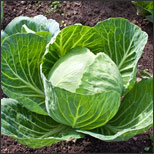Planting and Growing Cabbage Made Easy

Are you looking to add cabbage to your garden?
What did you plant or add to your landscape this weekend? Did you plant anything in your garden? Today, we are sharing all about planting and helping cabbage flourish.
Cabbage is great not only for your taste buds, but also for you body. This resilient, leafy vegetable is jam-packed with essential vitamins including vitamin K, C and folate as well with important minerals. It is also a good source of fiber and is low in calories.
Check out what WedMD had to say about the health benefits of eating cabbage.
Cabbage is used for stomach pain, excess stomach acid, stomach and intestinal ulcers, and a stomach condition called Roemheld syndrome. Cabbage is also used to treat asthma and morning sickness. It is also used to prevent weak bones (osteoporosis), as well as cancer of the lung, stomach, colon, breast and other types of cancer.”
Growing your own cabbage can be difficult. So let’s take a look at how to plant it. Growing healthy cabbage starts with planting it right.
5 Simple Steps to Plant and Grow Cabbage
- Start by planting small plants in a pot that you keep indoors about a month to two months before the last spring frost. While you are letting the seeds sit in the container, work compost into the ground where you plan to plant the seeds.
- Plant the cabbage seeds in the ground about 2-3 weeks before the first frost.
- The Old Farmers Almanac recommends to plant on a cloudy day about 12-24 inches apart. They also give a great tip about how to closer you plant the smaller the heads.
- The next step is for you to install Rootsticks. These Rootsticks will insure that your cabbages get the oxygen, water, and nutrients they require to grow tasty.
- Now you’ll want to add mulch to help the soil control its temperature.
What is your favorite way of cooking cabbage? My favorite is fried cabbage.



